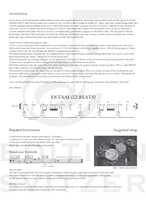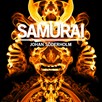
Ektaal Reflections
Composer: Søren Monrad
Instrument: Multi Percussion
Level: Intermediate
Published: 2012
Price: €22.00
Item details
-
Description +
-
Duration: 6 min.
I have always loved and admired Indian classical music and its great interpreters. Listening to great masters such as tabla gurus Pt. Suresh Talwalkar and Pt. Zakir Hussain makes you wonder if you ever will be able to grasp the depth of it. Many years ago I acknowledged that I as a western composer and percussion player never will be able to play the tablas properly, but since I fell in love with the Ektaal, I decided to reflect on it and try to transfer the ektaal-feeling on to western instruments and sounds. The instruments I have chosen for this piece is western modern instruments with only a fraction of soundcreating possibilities compared to the Indian tablas. The intensions of Ektaal Reflections is therefore NOT an attempt to sound like tablas and real Indian music, but to make a crossover between Indian and western music and to give all non-tabla players an opportunity to enjoy this beautiful taal.
Ektaal is one of Indias most popular taals.
TAAl is a re-occuring rhythmetic framework of certain number of beats divided in a particular way. Some taals contain only a few beats
while others have more than a hundred. In ektaal there is 12 MATRAS (beats) which is put together into 6 VIBHAGAS (groups) of 2 beats.
To keep track of the taal, the vibhagas has different meanings (accentuations).
The Indian musician learn "keeping taal" by clapping hands, a clap representing an accented vibhaga (SUM and TALI) and a wave of the
hand representing an "empty" vibhaga (KHALI) not accentuated.
These accentuations, by counting vibhagas, are not necessarily to be heard in Indian music, but is a tool to help you keep track of the taal.
I however have decided to let these vibhagas be heard and played on the hi-hat at some points.
The Indian musician learns the many different sounds and beats on the tablas by pronouncing the sound it produces. This is called BOLES and is often heard solo or simultaneously with the playing.
You should try to pronounce the ektaal boles as you think it would sound on tablas. This will you give an idea of how to phrase the taal.
If you are really into it, you might even be able to create your own "western-boles" taken from the sounds of your western instruments for this piece. You should feel free to try that out and maybe use it in the ad.lib vamp sections.
Above all, Ektaal Reflections should be played with a good groovy and virtuostic feeling and some good sense of humor. Have fun!
-
-
Instrumentation +
-
Multi-Percussion:
2 Snare Drums
4 Octobans
Hi-Hat
-
-
About the composer +
-
Søren Monrad was classically trained at the Royal Danish Conservatory of Music. In 1978 he became a percussionist with the Royal Danish Orchestra and in 1982 he won the chair as solo timpanist in the same orchestra. At the same time, he also held down jobs with the Collegium Musicum, Royal Danish Brass and others. Add to that a comprehensive international career as a solo percussionist, playing with among others the Royal Danish Orchestra and the Odense Symphony Orchestra.
He has also performed on several CD’s with the above mentioned ensembles on which composers such as Bartok, Crumb, Varese, Koppel and others are represented. Since 1985 he has been a lecturer at the Carl Nielsen Academy of Music in Odense, Denmark.
-
-
Reviews +
-
Review (Percussive Notes, July (60) 2012)
Based on Ektaal, one of India’s most popular taals (rhythmic frameworks), this eight-minute solo is the composer’s attempt to “transfer the Ektaal-feeling on to western instruments and sounds.” Extensive program notes serve as a minilesson on the pertinent information of Indian classical music as it relates to the solo. Additionally, the composer includes instructions on eclectic performance techniques (such as a reverse roll) and examples of ways to improvise during the multiple vamp sections included within the solo.
The over-arching feeling of this through-composed piece moves from rhythmically basic to quite active and complex. Anyone who has studied (or attempted to study) Indian classical music knows that even a focused season of learning only scratches the surface in terms of digesting, understanding, and producing appropriate sounds on the tabla. While a performer does not have to have extreme chops or fast hands to perform this piece, it will require a mature understanding of the rhythmic framework on which it is composed. This solo is perfect for inclusion in university recitals, or even in a semester study when fundamental elements of Indian classical music are introduced.
—Joshua D. Smith
-
-
Credits +
-
Front cover artist: Kirstine Monrad Have
Front cover graphics and layout: Kirstine Monrad Have
Copyright © Edition Svitzer
Printed in Copenhagen, Denmark
-





